I'm a hobbyist interested in re-designing and implementing a DC power supply providing a \$+5V_{DC}\pm 200mV\$ output with a current compliance of \$50mA\$ (I could live with \$30mA\$ successfully) from a \$230V_{AC}\$ @ 60Hz split-phase US mains supply. This supply will be completely sealed and there will be no access at all to any conductors outside the sealed package, except for the AC input wires. The DC is used with a microcontroller, which itself will also be inside this sealed package. So there is no way anyone can make any contact with either the DC ground or the \$+5V_{DC}\$ lines. Think of it as a brick with only the two hot AC power input wires, plus ground, leaving the brick. (It is actually a micro that accepts fiber optic signals and controls four SCRs as part of a hybrid relay system gating the \$230V_{AC}\$ for an H1/H2 output. But that's a longer story.)
My goal is to come up with an approach that uses the least volume while using reasonably available parts and/or ones I can reasonably fabricate. (Reasonable is something I can't define well, but it tends to mean that I don't want to use parts that are very expensive or very difficult to come by in hobby quantities.)
This opens up a few questions:
Just use a transformer to get the voltage down close, followed with a bridge, etc. I'm open to the idea of a custom wired transformer, but I suspect I'm going to run into difficulties because of the volt-seconds (Webers) that the core will have to sustain when operating with 60Hz. I think the volume is going to be huge. I need to delve into the specifics and I haven't done that, yet. The question here is: Is my intuition correct that the transformer volume will be large (compared to answers for the following questions), despite my modest current requirements?
Use a capacitive driven power supply. You can see an example of what I'm thinking about, given an existing design I posted here about two years ago: Split-phase \$230V_{AC}\$ transformerless capacitive power supply for \$5V@30mA\$ regulated output — series cap?. No answers developed from that one, but a similar design does work satisfactorily. A problem here is that the capacitor should be non-polar and rated for such use. These are large. This is the reference design I'd like to shrink. The question here, other than providing a reference for the other questions, is: I'm using a \$450V_{AC}\$ rated non-polar X2 capacitor now. Are there reasonable alternative capacitor choices I might consider that are smaller and yet rated for this exact kind of use?
Use some specialized IC designed specifically for this purpose. Those I've examined are complex to design and not so well tailored to my modest ~\$30mA\$ (to \$50mA\$) requirements, enough so that I'm once again not sure about the resulting volume. It would take quite some time to gather these up and test specific designs and given that none I've found are specifically designed for very low currents and voltages a question arises here. Are there any ICs that an experienced designer might suggest I look at, which has a promise of showing a total volume less than what is typical for designs as in (2) above and doesn't use overly exotic parts different to obtain or too expensive? (I'm looking here to narrow the work I have ahead. Not a perfect answer here. I can explore what is offered. So I'm just looking for reasonably educated IC suggestions, and not whole circuits using them.)
(In answering the above, I'm able to wind and test transformers and coils and I do have access to oscilloscopes, lab supplies, and the usual tools that a modest hobbyist might accumulate. And feel free to criticize the earlier design approach, too. I'm just a hobbyist and will take my lumps, with pleasure.)
The target volume is something smaller than \$1 \, in^3\$. The existing design uses commonly available parts.


